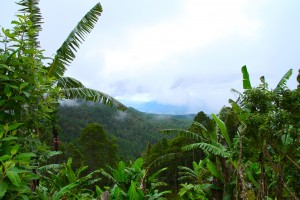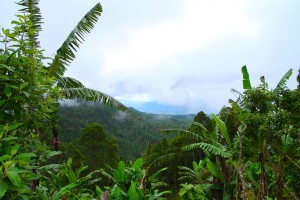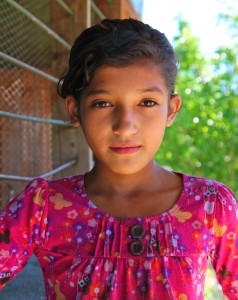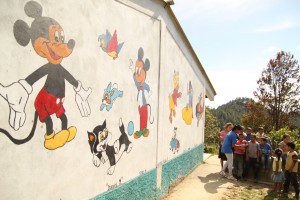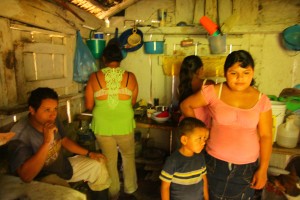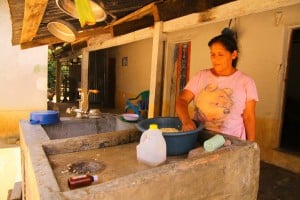Check out this amazingly well-written and detailed report from Ronak Shah, a Public Health Brigader from Indiana University.
Global Public Health Brigades
Reports and Stories
Honduras, Spring 2010
Tegucigalpa
The runway at Tegucigalpa is one of the shortest in the world. It’s said to be rather dangerous to land, because if you don’t brake well enough and in good time, you’ll run out of runway before you can stop. In spite of that, we had a stellar pilot, and the landing was quick, but smooth. The airport was old, but friendly. Things just worked out, and nobody really worried about it. That’s important.
Our first impression of the city, walking out of the airport, was a little bit different what we had expected. It was not swelteringly humid. Tegucigalpa is high in the mountains, and as you drive up and down the hills, you sometimes find yourself above the clouds, looking through a haze. Or just below, looking up, reaching, touching, swirling the mixture of vapors around like so much cream. The air was warm, but there was a breeze, here and there. There aren’t too many skyscrapers in the city—a couple, but it seems the people of Teguc found them ugly, and instead decided to densely pack together short buildings. Malls and slums, all together. More shocking, though, was the file of familiar fast food restaurants that greeted us. America. Yuck. That was a bit off-putting. But we didn’t spend much time in the city. We hopped on the bus and shoved off into the hinterlands.
The metamorphic drive was telling. As we exited the city, you could see loads of graffiti. Dirty, banal graffiti, but of resistance, no mere tags and shout-outs to the world. Stray animals wandered about like prairie fire. A washerwoman waved hello to us. Collapsed houses sat in the valley, pushed away by landslides. Then red dirt and lush vegetation. The smells in the tropics are far richer, far more frequent, far more intense. Something about the warm air seems to bring it out, the way cooking and spices bring out the flavor in meat and vegetables.
La Hacienda Rapaco
Rumor has it the old farmhouse used to belong to a former king of Honduras. It was used later as a brothel, and finally fell into general disuse until it was obtained by the Brigades for almost nothing. I don’t know about any of that. But we lived on a pretty impressive estate, with two large houses and a lot of bunkbeds. Nothing special. The toilets flushed, but wouldn’t take paper. Military showers were the order of business. Food was good, but with limited variety. So much the better that it wasn’t a paradise. I would have felt decadent, neo-imperial, but here I could at least believe that the luxury of my living was not a waste of money and resources. I don’t need much, and certainly I don’t need any more than how others here live.
A few animals hung around the compound. Stray dogs, for instance. Or perhaps not stray. It’s hard to tell when the compound is mostly walled, but surrounded by farmland. A dozen frogs spent their days in a small fountain pond behind the hacienda. Frog intercourse is a strange phenomenon. They will mount each other, but then jump around while mounted, and swim while mounted, and more or less go about their daily lives, such as they are, without seeming to realize they are making love.
We took a couple of hikes on dead trails behind the compound. Besides the road that our buses and trucks took up to the compound from the main road, a number of other roads shot off from the hill, blocked off by fences. One afternoon, we came back from work a little earlier than usual, and I felt a really intense urge to go down the trail and explore. I was able to round up an entourage of twelve others to join me, and we picked down the fence and got to hiking.
The first thing we came across, walking down the hill, was a copse of bamboo. I don’t think any of us expected it. Some of us had never seen bamboo before, and the rest found ways to demonstrate its many interesting features—the hollow interior was a wide telescope, a straw for the nearby creek, and the segments were the handle of an umbrella, were walking sticks, were rolling logs. That it’s a grass, not a tree, was a new fact to many, but of course, there is no bark! There is very little that bamboo and a tree have in common, save height, save hardiness.
We pushed forward and armed ourselves. One took a front of palm, another a stalk of bamboo. I found the bone of what looked like a young cow, or perhaps a talk. It was a femur, to be sure. Or perhaps a humerus. In any case, I, wearing my Honduran poncho, fit myself as a warrior. Continuing down the path, we starting coming across abandoned things. First a water tower, and some tanks, perhaps for feeding horses, or cattle. Overgrown grasses in front of gates. Then an entire row of farmhouses, latrines behind. I don’t know what happened to these lands, but they had been left free of human influence for a very, very long time. There were no possessions to claim.
We entered the abandoned compounded, and it was clear that animals had their way with the place. The doors were broken in, the latrines were broken to pieces, and all of the floors were covered in old animal dung. Though some of it was fresh. We looked for archaeology among the ruins. What we found was a bush of beautiful fuchsia flowers, which we would not have seen had we not entered the compound, for the flowers were facing away from us, and were hidden from view.
Scavenging among the crumbling tumblers awakens a deep mystique within me. We went again, that night, donning flashlights, headlights, and a bit more fear, a few more excited nerves. The same path, mostly. But coming down the hill were a few more frights, even as the stars shone overhead. A horse stood off the path at one point, unseen until we flashed a light upon him. One of us yelped, but another clasped his hand over her mouth, that the horse might also start and charge. I told ghost stories of travelers lost, and soon the fright became enough that most of us turned back. Yet a few pressed onward on unknown trails. Of course, nothing bad happened. Nothing would, there. Around the farmland, certainly all predators had been slaughtered long before. And among the abandoned lands, certainly no farmers would accuse us of trespass.
I went on a run the next day, early, as the sun rose. Running in a new land is one of the most potent ways to build a bond with it. My feet beat against hilly dirt path, kicking up a storm, and I felt myself picking up the soil, turning it, changing it by my presence, influencing the land here ever so slightly, but more than I might have had I slept it. Mountains swelled in the distance, sleeping under thick, low-hanging clouds. Some men had already hit the fields, and I waved as I passed them. Certainly, we were a familiar sight by then—many Brigades had passed through this compound, year after year, with a few athletes among them. Rapaco was a home base, a mountaintop to sing from.
Nuevo Paraíso
Near Rapaco is a town called Nuevo Paraíso, one of the first places that Global Brigades began working with. It has two halves. The first is El Barrio, or the neighborhood, which began has a village for single abandoned women and their children. It is now a children’s village for orphans, who live in small houses supervised by young women in the area. Brigades and other organizations build and sponsor homes for the children. The other is El Proyecto, where foreign missions tend to stay. In some ways the community is utopic, with mountains and mountains of support always pouring in.
We visited the orphanage on the first day there. At first it felt a little like visiting a zoo, and I was a bit uncomfortable. Not because of the kids. The kids were adorable, wonderful, fun. But because we would only be staying for a short time, visiting without building relationships, without bearing gifts (though they insisted on taking what few fun things we brought as surrogate gifts), but just to see and to play and to enjoy. That made me feel a little weird. While the other Brigadiers played soccer and other games with the younger kids, I spent most of my time there talking to two teenage girls, Gaby and Izbeli, wanting to practice my Spanish. They were really wonderful, and I gave Gaby my teleidoscope, which she really appreciated. They took me to a nearby church, and Gaby said mass for me. I didn’t get a chance to go to a service while I was there. I would have liked to.
The ages of the kids vary widely. Boys stay in the neighborhood until age 15, when they go to Flor Azul, a boarding school for boys. The school is said to be a model, and the boys there actually get a very good education, practically and academically, that allow them to look into a lot of opportunities that they may not have been able to before. The girls have no such opportunity however, and stay until age 18, going to a high school in the village. The education there is far more limited, offering only programs in welding, electronics, and computing.
This inspired our leader, Lauryn, to start working on building a school in the village. A few of us joined her one morning to meet with the principal of the grade school for the orphans, in order to start a pen pal program between the kids of the orphanage and students in a school in New York. He was very enthusiastic, and felt able to have response letters for us that evening. No red tape, no approval process. The flexibility and earnest hard work of the teachers and administrators of the school were incredibly admirable. But Lauryn, learning at that time of the problematic gender imbalance of education opportunities for students in Nuevo Paraíso, felt the imbalance needed to be corrected, and felt able to correct it. We are now going to support her in that, perhaps by fundraising. Maybe Mohsin and I will release a rap album.
Pajarillos
You can’t take a bus up there. The roads are too steep and rocky. You need to ferry in with hardy trucks and jeeps. About four or five hundred people live in Pajarillos, a small community on the mountainside. It’s one of the first communities that Global Brigades started working with in Honduras, and the first recipient of Public Health projects. The work is mostly subsistence farming. There aren’t really any cash crops grown there, and the people are quite poor. There is a school in town, that requires education up to the sixth grade. And there are a lot of churches, some catholic, some evangelical. But there’s not much of a health clinic, and there’s not much yet in the way of water programs. This is where Global Public Health Brigades comes in, building latrines, concrete floors, smoke-evicting stoves, and sinks, and integrating deeply with the Water and other projects. The community doesn’t pay any money for the projects, although masons from Pajarillos and other neighboring regions are paid for the labor they put in to help us build the projects.
But the projects have run into some problems, though. One landlord owns the majority of the land in the village, with the other residents as tenants. A few people on the outskirts of the village own their own land, which they’ve had for generations. What’s strange, though, is that the government has also designated Pajarillos as a natural preserve. As a result, the people living on land there have to ask permission in a variety of different ways in order to make changes. This seems to have become endemic to the attitude of the residents, who do not feel empowered to make decisions about their community. One woman we spoke to had a latrine on the property she was living on that she was using as a storage unit. We asked her why, and she mentioned that she didn’t have permission from the landlord to use the latrine. Yet when we asked her how the landlord responded to her inquiry, she told us that she hadn’t even asked. She felt too ashamed, she said.
You can’t really blame her, either. These people are not lazy or stupid, although they’ve gained the reputation among their neighbors for their behavior. I’m going to argue, rather, that aspects of the structure of this community and of the approach of the Brigades has prevented community coherence and interdependence, and it has caused a number of the public health projects to go poorly. Latrines have been left unused, stoves haven’t been cleaned, things have slid back into an unfortunate status quo. This prompted the Public Health Brigades to pull out after about a year of work, although some of the other brigades stayed on in the community.
One of the nice things about a nonprofit, compared to a government is the ability to “love unconditionally,” in a sense. A state cannot pour endless tax dollars into a region if its constituents see the money as being wasted there. “Oh, they’re just a bunch of good-for-nothings. We won’t elect you if you spend money there without accountability.” So you have a history of failed dealings between Pajarillos and its government that has contributed to their own lack of empowerment and engagement. They put together the funds to get electrical poles in their town, and the government erected them, but then failed to put in actual power. So now there are just a lot of empty poles. They put in a request to the government for disposal bins, and the government said it would comply, and yet no action has been taken in almost a year. It is not the government that can break the cycle of poverty and disempowerment in Pajarillos.
So Public Health has returned, but with a new approach and with new rhetoric. The community has been organized into a number of different committees, for instance for water or public health, composed of the more active and dedicated members of the community. Things have been moving, now. We attended a pair of community meetings on the second day, one of committee members and one of the whole village. The rhetoric was a little patronizing, didactic, and repetitive, but perhaps not in a bad way. It was clear that members of the community still conceived of themselves as individuals, while the Brigades desired them to be part of a community. Interdependent, trusting. For example, one man at the meeting lived in a house just above the water tank. As a result, he could not get water flowing directly to his house, while most other houses could. The Brigades pointed out that it was simply too costly to build a pipe to accommodate just his house, and that he would have to depend on neighbors for water. This sort of back and forth went on for a while, and was indicative of the sort of conflict that arises often with development projects—convincing people who are looking up to you, to look around at each other.
We spent a lot of time going from house to house assessing the needs and negligence of scores of residents in the village. Many of the houses were really in shambles. Dirty, falling apart, stray dogs running about with few smiles on the faces of the people. Many women had been left alone, living with their mother and children. Many men had no home at all, and slept where they could, or with their families at times. People’s conception of “home” seemed to be loosely tied to “shelter,” but otherwise lacked much semantic content. Yet a few of the houses were definitely homes. Lush, verdant gardens, clean floors, a pet parrot in one house, collared dogs. Some people definitely took some care of their land, perhaps because they had more means, perhaps more time, perhaps more people to depend on, perhaps just a greater disposition to keep their part of the world in order.
There were a lot of symbols. A skinny black dog followed us around the village, from house to house. Scattered everywhere were torn, dirty, sometimes burnt fragments of Bibles, certainly the only book to be found in the village. One child’s toys were rusty pop cans, crunched apart and certainly dangerous. Welts and cuts called out from most children’s bare feet.
There is always such a contrast between the natural beauty of these places and the putrid lifestyles of the people living in them. I thought a lot about beauty while I was there. Why did we evolve to have such a sense of mystique at beautiful landscapes? Was it, perhaps, that when we became conscious as a species, that we needed some way to justify our existence? That thinking about existing made us hate it, hate the idea of it, of the meaningless of it all? And so the only ones that could survive were those who could see beauty even where it was not? Were those that could somehow fabricate a willingness to live from the normalcy surrounding them?
Let’s end on a happy note, though. My hypoglycemic friends and I were getting pretty thirsty at the community meeting. So we went out to the local convenience store to get a refreshment of some kind. The guy there had no water, but he was able to give us a nice big Pepsi. Unfortunately, all we had were dollars; but, I was with two girls! There were some young guys at the corner table that seemed to take a liking to us, and they bought our drink for us. Really, really wonderful of them. Normally, I hate cola. But as we walked back, we might have been in a Pepsi commercial, so refreshing was that drink.
Joyas de Caballo
Joyas de Caballo is a bit different, and I want to outline a few comparisons with Pajarillos. Joyas is about the same size, although a bit less poor. They grow coffee as a cash crop, and this seems to have made a huge difference in what resources the community has. It has a health clinic, though, admittedly, it isn’t the best—it is closed for a hefty part of the spring. It has a much better road, allowing for much more incoming and outgoing traffic, and has instituted a bus that runs twice a day through the village. Compulsory schooling goes up to 9th grade, rather than 6th grade.
Of greater interest, perhaps, is how land ownership differs. Rather than having one big honker of a landlord, most of the land is owned by small-time landowners who own just a few properties, or by individuals. What’s more, consciousness of ownership seems to be fairly slack. People spend a lot of time on other people’s properties, for work or play. Permission does not seem to be such a rigid requirement for use as it is in the minds of those living in Pajarillos.
Finally, implementation of the projects themselves differs quite a lot. Rather than getting the projects constructed for free, the citizens of Joyas pay 20% of the cost. The money doesn’t go to Brigades, but instead directly into a microfinance bank that the Microfinance Brigade has constructed in the village to give out microloans, primarily to enterprising women. This difference is partly because the people of Joyas can afford it. But the effect of this policy is that the people of Joyas have already “bought into” the projects and put a bit of themselves and their effort into them. This seems to lead to a lot more engagement and a lot more optimism. There is a lot of cognitive science literature about differences in satisfaction depending on whether you receive something as a gift or you purchase it, and that definitely seems to have been put to good use here.
So the people of Joyas have a reputation for being optimistic, hard-working, and grateful. The community is quite strong, binding together and depending on each other to build things up and get things done. The goal is for the microfinance bank to fund the second half of the projects that Public Health wants to implement, while Brigades will fund the first half. In other words, the goal of Brigades is ultimately to make development there sustainable.
Brigading
As we work, undoubtedly a number of ethical issues come up. Here I highlight some of the core concerns. First: the primarily function of much of the work done by Global Brigades is to build communities. Each Brigade, one way or another, contributes to achieving this goal. However, building a community is also building opportunity, and building opportunity is building, for the youth of that community, pathways out of it, pathways that seem to lead to greener pastures. For those youth that take the escape route, there is no guarantee that they will return to work for the community again, no matter how idyllic or close-knit the community is. Sometimes those pathways also lead to other cultures. Western music and clothing, for instance. Individualistic values. Cultural constellations that may be entirely incompatible with the way the community operates and survives. So the trouble is clear: if building a community in this way serves, in fact, to ultimately tear it apart, is it ethical to build these communities? Is it ethical to present attractive alternatives to people who are relatively happy and comfortable in the status quo? Or, more optimistically, is there a way to design community-building so as to avoid the harm of tearing communities apart in the process? Is there a way to maintain in the minds of the youth a priority that the community is the most important thing that an individual can have, and that all material possibilities are secondary, are subservient? For I know that I, of all things, would love for a community like some of those that we visited, in spite of the poverty, in spite of the lack of variety, of freedom of choice, of opportunity. Opportunity for me has always been a means to the same end, which is that of community. Even if we live on subsistence and nothing more, what more do we really need when we have community?
There is also the more obvious dilemma of neoimperialism: how do we help people when we do not really understand their language, their culture, their lifestyle, their needs, and their work? We are so, so distant, and have so little time to really pull in close. Is it ethical to enter their world and claim to possess a form of knowledge that they ought to desire? Or is that patronizing? Is that presumptuous? These days, when travelling, I build an assumption that natives know ten times as much as I do. That may be false, and I may legitimately have good advice or insight for others. But if I am staying for such a short time, the benefit of the doubt leads me to prefer an assumption that they are all-knowing, wise beings who ought to be trusted. But there is a clear temptation in that line of thinking to be as laissez faire as possible, to leave most of the work to the community, to allow them to build themselves. What should we do, what should we assist in, and what should we steer clear of?
Finally, of more practical importance is the question of distribution of aid. Do we help those who engage the most with the projects, or those who need the most help? The pay off and the trickle-down effects of the former category may be greater. But the heart-call of the second category cannot be ignored. It seems unfair to focus on those with the greatest need for outside resources, rather than those who seem to have more intangible resources or more dispositional ability to make good use of aid. Especially if the latter group is hardworking, it would be wonderful to reward them in some way. And yet we are not training animals. Reward is a terrible word for this, isn’t it? One way around this seems to be by giving resources to those who need the most help, and giving power to those who need the least help. But over time, this leads to a system based in socio-economic class, rather than an egalitarian system, and the troubles of such an arrangement are obvious. Another method is to pursue both paths at once, but for an organization with less than infinite resources, at some point a decision over the line must be made. The likely choice will probably have to remain case-by-case, with certain projects being implemented uniformly, and others differentially. Perhaps this is the only way that change can really take place: ad hoc.
Food
Something I will never understand is that in spite of having more wealth and more variety of food choices in the United States, food in poor, rural villages of Honduras is still far superior to our own. What do we need industry and civilization for, anyways?
I should start with the coffee. Sweet and rich. They grind up the beans with the sugar, and they seem to add a lot of sugar. The drink isn’t like it is here, as rapid fuel to get through the day. It’s a drink of leisure, more like tea, and we’d take a cup or two with cookies taking a break from work. That was the specialty of the region, and we bought bags and bags of it, coming home.
And the fruits. Plantains, oranges, mangos, pineapples, papayas. You name it. Fresh from the vine or tree. Everyone’s yard had trees and bushes laden with produce. I find a lot of beauty in the terraces of farmland, the ordered grids of crops and the endless lines between them. Especially when the landscape shifts from crop to crop, and the landscape turns a different sort of green as the texture shifts from rice to maize to wheat.
The food at our compound was always incredible. The baleadas and pupusas, local fare that we got in town, were incredibly rich. And the paleada in the village was sweet, hot cream for the soul. I can’t say enough about it. These people are poor, but rich in so many small ways.

